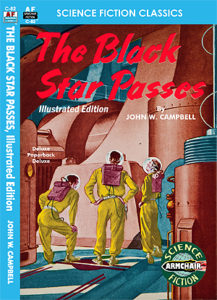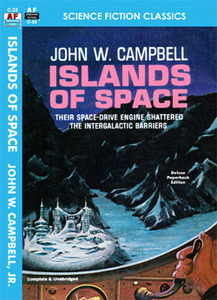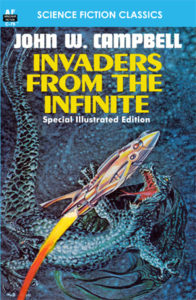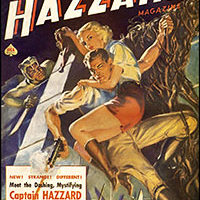 Sometimes we overlook the science fiction of past decades. The science is often dated, based on ideas misunderstood or discredited, their view of the future sometimes laughable. And characterization is stiff and unrealistic. But it often shows an energy and creativity that is missing in today’s more realistic science fiction.
Sometimes we overlook the science fiction of past decades. The science is often dated, based on ideas misunderstood or discredited, their view of the future sometimes laughable. And characterization is stiff and unrealistic. But it often shows an energy and creativity that is missing in today’s more realistic science fiction.
An example of this are the space adventures of scientists Arcot, Wade, and Morey written by John W. Campbell Jr. Campbell is usually remembered for his editing of Astounding Stories that set the tone for science fiction for decades, but he was also an author in his own right.
The three Arcot, Wade, and Morey books have been recently reprinted by Armchair Fiction in very nice editions, and this is my first time reading them. These stories appeared first in Amazing Stories, then were later edited for their book appearance. These editions reprint those versions with some extras.
<!-more–>The Black Star Passes is the first book, which is actually a combination of three short stories that appeared in Amazing Stories (June and November 1930) and Amazing Stories Quarterly (Fall 1930). The Armchair Fiction edition reprinted the cover from the Fantasy Press edition along with the interior artwork from the magazine appearances.
 Islands of Space is the second book, and features a novel that appeared in Amazing Stories Quarterly (Spring 1931). Armchair Fiction reprinted the cover used on the Ace paperback edition of the novel, but didn’t do anything else.
Islands of Space is the second book, and features a novel that appeared in Amazing Stories Quarterly (Spring 1931). Armchair Fiction reprinted the cover used on the Ace paperback edition of the novel, but didn’t do anything else.
Invaders from the Infinite is the third and final book, a novel that appeared in Amazing Stories Quarterly (Spring-Summer 1932). Armchair Fiction again used the cover from the Ace paperback edition along with the interior artwork from the magazine.
As noted, The Black Star Passes is really a collection of three stories. We are introduced to the three characters in the first story, “Piracy Preferred.” In the early 22nd century, a dangerous “air pirate” is preying on Transcontinental Airlines. These ships carry 3,000 passengers and a crew of 70! The air pirate knocks out everyone and takes valuable securities. The world’s greatest physicist, Dr. Richard Arcot, with his mathematical assistant Robert Morey, works to understand how he does it and designs the “molecular motion drive.” Design engineer John Fuller (almost a fourth member of the group) helps to create it, which they use to build a new aircraft to stop this air pirate. Oh, what about Wade? Well, he is a brilliant chemist, and is the air pirate himself! His criminal actions are due to a neurosis, and after captured, he is cured and become a part of the group.
In the second story, “Solarite,” using the molecular motion drive, the four build an interplanetary spaceship and travel to Venus, which they find is inhabited by a humanoid race with blue blood (and skin) and double thumbs. They also find that the world is divided into two nations, and one is attacking the other. They come to the defense of the attacked nation, and find allies after learning their language through telepathy. They also learn that the aggressor nation plans to attack Earth! It is strange that it’s not till the 22nd century that man is traveling to other planets.
 In that third story, “The Black Star Passes,” a dead star with planets passes near our solar system. The planets of this system are inhabited by a humanoid race who hope to take our Sun, not realizing that the inhabitants of the solar system will stop them, which they do. This is because the inhabitants of the Black Star system aren’t adept at war, whereas Earthmen and Venusians are. So it’s the super-science of the solar system versus the super-science of the outsiders.
In that third story, “The Black Star Passes,” a dead star with planets passes near our solar system. The planets of this system are inhabited by a humanoid race who hope to take our Sun, not realizing that the inhabitants of the solar system will stop them, which they do. This is because the inhabitants of the Black Star system aren’t adept at war, whereas Earthmen and Venusians are. So it’s the super-science of the solar system versus the super-science of the outsiders.
In Islands of Space, the group takes to the stars in their molecular motion drive. And we can’t get just a basic travelogue, so they find a pair of alien races fighting a war and again fall in with the “good guys” and help them out.
And finally in Invaders from the Infinite, we are visited by intelligent dog-like humanoids, who ask our help against a dangerous foe. And the trio of scientist-adventurers do, of course.
While the science is a bit hokey, the action is fun in this trio of books. For that, these are worth reading.



